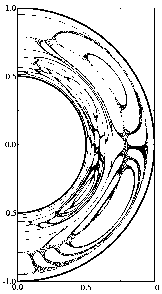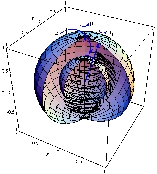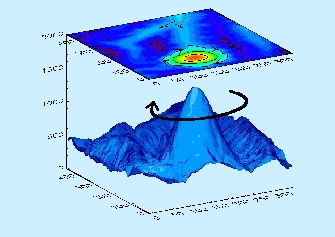


|
|
|
|
OCEANOGRAPHIC APPLICATIONS |
Fluid flow is ubiquitous in nature and in technological processes. It is observed in scales ranging from the very large (cyclones in the atmosphere, ...) to the very small (blood flow in microscopic capillaries, bacterial swimming, ...). The research activities of DFI-IMEDEA during 1999 in this field addressed two fronts: on the one hand we studied basic processes in transport by fluid flows, namely in the context of chaotic advection; on the other hand, applications to oceanographic flows and to the transport of biologically active substances in the sea were developed.
|
THE TRANSPORT AND MIXING OF PARTICLES BY LAMINAR FLUID FLOWS |
 
|
Fluid motion transports particles and substances contained in the fluid.
The efficiency of mixing processes strongly depends on the characteristics
of the fluid motion. Chaotic advection is a phenomenon by which simple
flow patterns can produce very complex trajectories for the particles suspended
in it.
|
|
TRANSPORTED BY FLUID FLOWS |
| Turbulent and even some smooth fluid flows distort fluid elements and the substances in them originating a rich fractal structure. The geometric characteristics of the resulting distributions strongly influence chemical reactions or biological processes occurring among them. |
|
| We have characterized geometric properties of distributions of reacting
substances in Lagrangian chaotic flows, and applied the results to particular
first order chemical reactions, and to models of phytoplankton and zooplankton
competition in ocean flows.
Z.. Neufeld, C. López, P. Haynes, Phys. Rev. Lett., 82, 2606 (1999); Z. Neufeld, C. López, E. Hernández-García, T. Tél, Phys. Rev. E 61, 3857 (2000) |
|
|
It is a long standing observation that, in the absence of strongest forcings such as wind stress or instabilities, marine currents tend to follow topographic features. Although several mechanisms have been proposed to explain this fact, a detailed understanding was still lacking.
We have identified a mechanism that explains the observations of marine currents associated to topographic features (submarine mountains or valleys). It is a kind of `noise rectificationí mechanism related to the one appearing in other fields of science, The direction of the currents generated is determined by the statistical properties of the small scales of turbulence
A. Álvarez, E. Hernández-García, J. Tintoré, Phys. Lett. A 261, 179 (1999); Geophys. Res. Lett. 27, 739 (2000).

An eddy appears on top of a submarine mountain as a result of the interaction between turbulence and the topography. The rotation sense of the eddy changes from anticyclonic (top) to cyclonic (bottom) as the proportion of small scale turbulence is increased.
|
|
|